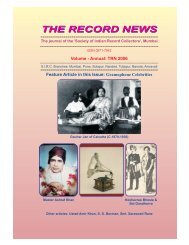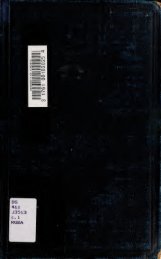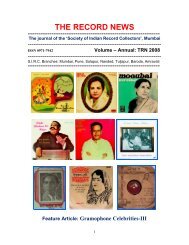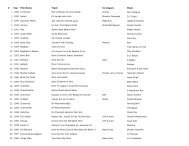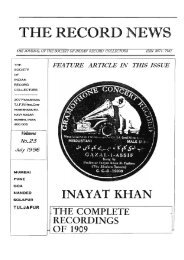THE RECORD NEWS - Hindi Movies / Films Songs
THE RECORD NEWS - Hindi Movies / Films Songs
THE RECORD NEWS - Hindi Movies / Films Songs
You also want an ePaper? Increase the reach of your titles
YUMPU automatically turns print PDFs into web optimized ePapers that Google loves.
During 1908, T. S. Ramchunder & Bros. acquired their own recording machine<br />
from their agents in London to make further recordings for their label. Using this<br />
machine, next series of recordings were taken under the supervision of<br />
Shivshankar Ramchunder and assisted by Harishankar Ramchunder. They were<br />
later joined by Narayandas Purshottam in 1909. While the actual recordings were<br />
taken by T. S. Ramchunder & Bros. at Bombay, the matrices were shipped to<br />
Berlin for manufacturing disc pressings.<br />
In the meantime, The Gramophone & Typewriter Ltd. had raised an objection to<br />
the use of the name ‘’Rama-phone’ sounding similar to their trade mark<br />
‘Gramophone’. The matter was taken to court, enforcing an injunction on the use<br />
of the word ‘Rama-phone’, thus forcing T. S. Ramchunder & Bros. to change<br />
their label name to ‘RAMAGRAPH DISC <strong>RECORD</strong>’ with all stocks having to be<br />
pasted over with the revised brand name.<br />
In November 1912, Lyrophon=werke, Adolf Liben & Co., was converted into a<br />
limited liability company in the name of Lyrophon=werke, G.m.b.H., which in<br />
1913, was absorbed into Carl Lindström A.G., conglomerate. Carl Lindström A.G.<br />
continued to press the ‘Rama-Graph Disc Record’ including the back catalogue<br />
releases, with the addition of new series in the 1000, 2000 and 3000 numerical<br />
blocks. According to Harishankar Ramchunder, who worked with T. S.<br />
Ramchunder & Bros., from 1905-1941, the discs were also pressed in Germany<br />
by one or two other ‘makers’ and suggested that the Nigrolit-Werke, G.m.b.H. of<br />
Berlin might have been one of the pressing factories involved.<br />
During World War I, record supplies from Germany were curtailed and the<br />
activities at Ramagraph in Bombay came to a complete halt. T.S. Ramchunder<br />
died in 1922 and the control of the business passed on to younger family<br />
members. In 1927, T. S. Ramchunder & Bros., turned to The Viel-o-phone Co.<br />
Ltd. to have pressings made of some of the back catalogues along with a new<br />
series of ‘electric’ recordings. The whole back catalogue was renumbered to<br />
various series with a prefix letter R- and the label colour changed to red and<br />
renamed to simply ‘Ramagraph’. The ‘Viel-o-phone’ pressings were rather rough<br />
and gritty, so following a couple of pressing runs, T. S. Ramchunder & Bros.,<br />
reverted to sending the stampers to Germany for reproduction by Carl Lindström<br />
A.G., Berlin. The design of the record label was made more attractive, and<br />
changed to a red-orange colour. This arrangement continued well up to 1931,<br />
however a complication arose with the merger of The Gramophone Co., Ltd., and<br />
Columbia Graphophone Co., Ltd., (who controlled Carl Lindström A.G.) in April<br />
1931. The ‘Columbia’ and ‘Odeon’ labels operated by these companies<br />
introduced to the Indian market in early 1930’s were now under the control of<br />
Electrical and Musical Industries (E.M.I.), Ltd., as was the ‘Odeon=werke’<br />
pressing plant who produced the ‘Ramagraph’ discs for T. S. Ramchunder &<br />
Bros., through to 1933. An offer was made by The Gramophone Co., Ltd., in<br />
India, to purchase the masters of the ‘Ramagraph’ label, however, T. S.<br />
Ramchunder & Bros., declined the offer, and also to join the ‘private recorder’<br />
36



